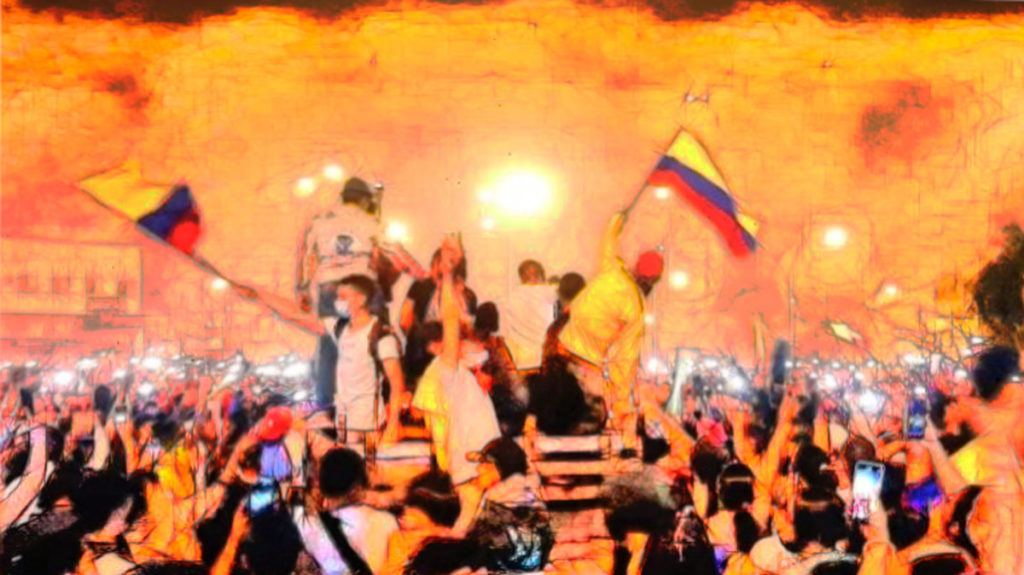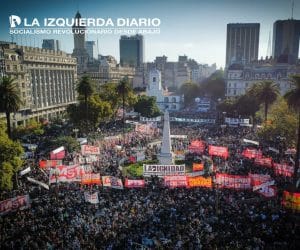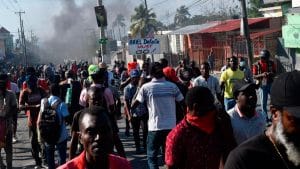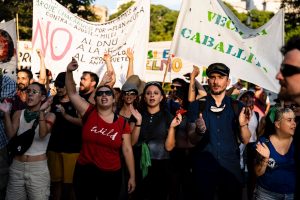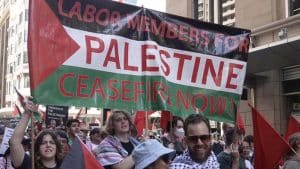“If people go out to protest in the middle of a pandemic, it is because the government is more dangerous than the virus.” That phrase went viral in a video by Residente, the popular Puerto Rican rapper, in which he expressed his solidarity with the people of Colombia. But before that it had been read and seen on thousands of banners in the streets of Bogotá, Cali, Medellín, and dozens of cities throughout Colombia on the first day of the National Strike against President Iván Duque’s regressive tax reform, on April 28. Since then, Colombia has been in a state of rebellion.
The Situation
The current uprising comes at a point of national political conjuncture defined by the pandemic crisis, the social catastrophe, and the political crisis of Duque’s government and his (extreme) right-wing Democratic Center party. It is the third and most important popular uprising against the neoliberal agenda and the repression of a police state Duque has faced since taking office in 2018
With the so-called “Sustainable Solidarity Law,” Duque sought to make workers, the poor, sectors, retirees, and the middle classes foot the bill for an economic crisis that has deepened with the pandemic. The package included the elimination of exemptions and a rise in the value-added tax (VAT) on basic consumer goods, lowering to just over $600 the income threshold at which taxes on wage earnings kick in (just more than two minimum wages), and a tax on pensions. On top of that, the main beneficiaries of state assistance in 2020, during a recession caused by the pandemic and the quarantines, were already the big capitalists such as Avianca (the airline got a US$370 million bailout) and the financial system. The government’s main objective was to reduce the deficit, which in the last year rose to 8 percent of GDP, and thus maintain Colombia’s credit rating and show itself as reliable to the International Monetary Fund (IMF) and international finance capital.
Duque tried to sell the (counter-)reform almost as an act of altruism — to increase tax collection and thus be able to extend state spending on social programs for a few months. Of course, he did not succeed, because anyone capable of adding two plus two could clearly see that between 75 and 83 percent of the taxes collected would come from the poorest sectors, leaving the profits of the big capitalists untouched. To make matters worse, Duque chose the most inopportune moment to announce such an attack on people’s pocketbooks: in the middle of the third wave of Covid-19 and on the very day that the National Administrative Department of Statistics reported that overall poverty in Colombia had climbed to 42 percent, extreme poverty to 15 percent, and unemployment to 17 percent (that is, in a population of 50 million, 21 million people are poor, 7 million eat only once or twice a day, and 4 million are jobless).
You might be interested in: “We’re Together in this Fight”: Hundreds of Messages of Solidarity from Myanmar to Colombia
This explains why Álvaro Uribe, Iván Duque’s mentor and charterer of the most rancid right-wing paramilitary within the Democratic Center, has distanced himself from the tax reform and from Duque himself. He recognizes that this deeply unpopular measure would at a minimum ruin his party’s prospects in the 2022 presidential elections. At present, Gustavo Petro — a senator from the center-left Colombia Humana party and former member of the M-19 guerrilla movement who is running as the candidate of a broad alliance known as the “Historical Pact” — enjoys a comfortable lead in the polls.
This acute situation of class struggle shows that the terror inflicted by the state and the ruling classes during the decades of the dirty war against the FARC guerilla army to maintain order by force of arms has been exhausted. To be sure, a warlike conception of the fight against social protests remains in force, as clearly expressed by Álvaro Uribe — who from his Twitter account agitates for the intervention of the armed forces and speaks of resisting the “dissipated molecular revolution,” a pseudo-esoteric concept used by various fascists to reduce popular mobilization to the work of infiltrators and thus justify state violence. Just since the signing of the peace accords with the FARC in 2016, some 1,100 union, peasant, and popular leaders have been assassinated.
The situation in Colombia is a headache for U.S. imperialism, which has played a central role in the development of the Colombian state’s dirty war through the so-called “Plan Colombia.” This program of military collaboration, established with the excuse of fighting “narco-terrorism,” established an unprecedented level of U.S. interference in the region. Under the presidency of Joe Biden (a fanatical defender of “Plan Colombia”), Iván Duque and the Colombian extreme right, once counted as part of the Donald Trump camp, continue to be fundamental allies in the policy of U.S. hostility towards Cuba and Venezuela.
The Uprising and Its Prospects
Duque withdrew the reform on May 2, and its neoliberal author, Minister of Finance Alberto Carrasquilla, resigned the day after — two of the main demands of the political opposition to Duque’s government. Nevertheless, mobilizations, national strikes, and confrontations with the police and their ESMAD (Mobile Anti-Disturbance Squadron) death squads have continued.
At the time of this writing, there have been 10 straight days of mobilizations and strikes, more than 30 dead, and hundreds wounded and disappeared. Like any process of class struggle that takes on a historical dimension, this uprising of the Colombian people has its symbols in all those murdered. And it even has its capital: Cali, the country’s third-largest city, has been declared “capital of the resistance” and remains the epicenter both of the most radicalized confrontations led by precarious, unemployed, and loosely organized youth and of the activities of the paramilitaries and hired killers.
Before considering some hypotheses regarding the possible dynamics that could unfold, it will be useful to summarize some key points.
The uprising. We can see just how deep the unfolding process is by looking at the analogies being raised by intellectuals and analysts, who cite the great national rebellions such as the massive Bogotazo riots of 1948 or the civic strike of 1977. This is the third act of an ascending cycle of class struggle that began with the national strike of November 21, 2019, as part of the wave of uprisings and protests in South America that reached its highest points in the rebellions in Chile and Ecuador.
With the slogan “Stop to move forward,” November 21 had as its central drivers the deep discontent over austerity measures, state and paramilitary violence against union, social, and peasant leaders, and the permanent boycott by the Duque (and Uribe) governments of the peace accords that the previous president Juan Manuel Santos had signed with the FARC in 2016 (and then “downsized” after a “no” vote surprisingly prevailed in the referendum that was to ratify them). It left as a tradition new forms of struggle and organization, such as neighborhood assemblies.
After a tense pause resulting from the outbreak of the pandemic and then the quarantines, the second act of this process took place in September 2020. Then, the trigger for violent days of mobilizations was the brutal murder of Javier Ordoñez by the National Police, which was recorded and broadcast on home video.
We are now experiencing a third moment of national concentration of workers’ and popular anger, catalyzed by the tax reform and the enormous unpopularity of the Duque government. In this cycle, both protests as well as state repression have escalated: in 2019, four were killed in the repression; in September 2020, 13 protesters were killed in Bogotá; but as of this writing there have already been more than 30 deaths in the current uprising.
Driving forces and their direction. As in 2019, the current popular uprising is led by an alliance of unionized wage earners, precarious youth from poor neighborhoods, students, progressive people from the urban middle class, the indigenous “minga” collectives, peasants, and the most impoverished sectors in general. The bureaucratic leaderships of CUT and CGT trade union confederations, which make up the so-called National Strike Committee, have adopted a policy of calling one-day work stoppages, which conspires against the organization and preparation of a general strike to unify all the sectors in struggle behind the objective of overthrowing the Duque government. This lack of unity of purpose poses the danger that the strength of the mobilization will gradually be exhausted in scattered actions and partial confrontations.
However, as political scientist Álvaro Jiménez Millán (former M19 spokesman in the peace negotiations with the Betancur government) has pointed out, union bureaucracies do not lead from one end to the other. Instead, there is an important degree of spontaneity that can be seen in actions by a more radicalized vanguard that does not heed the call for conciliation and a peaceful response to state violence. This tension between the bureaucratic leadership of the National Strike Committee and a more dispersed but also more radical youth had already been evident in the 2019 mobilizations. What could happen again in a situation of social catastrophe and political crisis aggravated by the pandemic and its consequences?
In short, if the perspective of bringing down the government has not yet opened up clearly, it is mostly due to the action of the trade union and political leaderships.
The dialectic between repression and dialogue. The government of Duque, who spent days hanging by a thread with no clear political support, even from his own party, has adopted a two-pronged strategy to dismantle the movement: repression plus dialogue. This classic formula of the ruling classes and their states to take down revolutionary processes is the same tactic Duque used against the 2019 protest, when he set up a “dialogue roundtable” that was promoted along with the church and businessmen with aim of diffusing the demands. In a sense, it was also Lenin Moreno’s tactic in October 2019 in Ecuador, when he invited the leadership of the Confederation of Indigenous Nationalities of Ecuador (CONAIE) to a roundtable and together they took the masses out of the streets. In essence, this approach involves stigmatizing the most radical sectors of the vanguard — who are accused of being “vandals,” “looters,” and, particularly in Colombia, “terrorists” — in order to isolate them and legitimize repression against them, along with creating a climate conducive to “peaceful protest.” It is another way of separating vanguard and masses.
The center-left opposition to Duque. Both the Coalition of Hope and Gustavo Petro’s Historical Pact have been working to make the dialogue policy successful. Petro spelled it out explicitly in a meeting with the National Strike Committee, telling its members they should have “declared victory” after Duque’s withdrawal of the reform. Further, noting the distance between the union leaderships and the precarious neighborhood youth who continue to fight and do not want to go home, he advised them to define one or two immediate objectives and sit down with the government for a dialogue. In this way, they render an invaluable service to the ruling class, acting to save the weakened Duque government, avoid its revolutionary ouster, and consolidate the diversion of the process towards next year’s elections. The process is still open ended.
This Period in Latin America
The popular uprising in Colombia is part of a Latin American dynamic that is becoming explosive. The drivers of this cycle of class struggle in Latin America are profound and long precede the pandemic. In fact, they go back to the early 2000s, which led to the revolutionary days of 2001 in Argentina and the water and gas wars in Bolivia. Having worn down the initial cycle of “post-neoliberal governments” with the end of the commodity boom, the return of some of these variants — after failed right-wing experiments such as the Alberto Fernandez government in Argentina and Luis Arce in Bolivia after the defeat of the coup plotters, and under the conditions of the pandemic, economic crisis, and commitments to the IMF — have not succeeded in recreating the old illusions among the mass movement.
The region’s economy, in the wake of mediocre years of recession and low growth, contracted by 7 percent in 2020, more than double the world average. According to an ILO report, there are at least 158 million people working informally in Latin America and the Caribbean, equivalent to 54 percent of the workforce.
Despite rising commodity prices and low interest rates, the outlook for 2021 is not encouraging. The emergence of the p.1 (Manaus) strain of the coronavirus triggered a second (and in some countries third) wave of the disease much more lethal than the previous ones, leading to new restrictions and partial closures, while vaccination is slow in most countries. The IMF forecasts that pre-pandemic per capita income will not recover until 2025.
In a Foreign Affairs article, Luis Alberto Moreno, the Colombian conservative party diplomat who served as president of the Inter-American Development Bank for 15 years (succeeded in 2020 by the pro-Trump Mauricio Claver-Carone), argues that Latin America is on the verge of a new lost decade, with alternating episodes of inflationary spikes, debt crises, and falling incomes. “If nothing is done,” he warns, “Latin America will become an even greater source of instability, from which no one — neither its elites nor the United States — will be immune.”
In the same vein, a Washington Post editorial advises “the United States and other rich nations to quickly expand covid relief measures to Latin America and other poor regions” and concludes, “If the virus is not brought under control in the coming months, not only Colombia but much of the region around it could be destabilized.”
You might be interested in: The Global South Is Dying and There Is Blood on Joe Biden’s Hands
The heat map of the regional class struggle indicates that with varying intensity, whether against governments of the neoliberal right or the self-styled progressive “center left,” the trend towards direct action has returned. All of these examples are part of this more general trend: the protests in Peru and Guatemala in November 2020; the outbreak of popular anger in Paraguay in March 2021; the strike of the dockers and the day of struggle on April 30 in Chile; and the struggle of striking healthcare workers in the province of Neuquén in Argentina, who blocked access to the Vaca Muerta shale deposit, the main investment of local and foreign capitalists.
In some instances, this return of the class struggle is combined with weak electoral politics that fail to consolidate as detours. That is the context for the crisis opened in Peru with the second round of the presidential contest between Pedro Castillo and Keiko Fujimori.
Duque’s tax reform, like the 30-cent subway fare hike in Chile in 2019, was just the detonator of the outburst, the straw that broke the camel’s back, amid growing indignation and rage among the working class and the poor. It is not by chance that it is in Colombia, Chile, and Peru that the processes of struggle and political crisis of the bourgeois regimes are most acute; these are the countries ruling classes and their political-intellectual personnel put forth as the shining examples of “successful neoliberalism.”
This does not mean there are not reactionary counter-tendencies and poles of attraction, such as the government of Jair Bolsonaro in Brazil — although now in crisis — or the government of Nayib Bukele in El Salvador, nor that Caesar-like and authoritarian tendencies are not emerging. But it is precisely these tendencies that in their own way confirm that a stage of more acute clashes has opened between the classes and, in that sense, between revolution and counterrevolution. It is a perspective that reinforces the need to build revolutionary parties and an international revolutionary leadership that will allow these struggles to be led to victory.1It is to this end that we present “The Capitalist Disaster and the Struggle for an International of Socialist Revolution,” the manifesto approved by the leaderships of the groups of the Trotskyist Fraction – Fourth International in April 2021.
First published in Spanish on May 9 in Ideas de Izquierda.
Translation by Scott Cooper
Notes
| ↑1 | It is to this end that we present “The Capitalist Disaster and the Struggle for an International of Socialist Revolution,” the manifesto approved by the leaderships of the groups of the Trotskyist Fraction – Fourth International in April 2021. |
|---|


